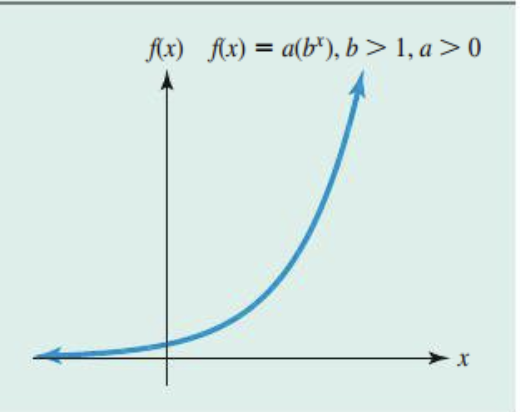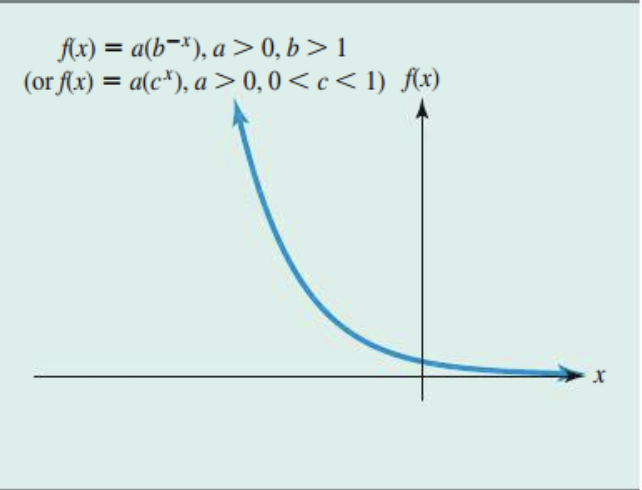Exam II: Logs and exponential functions
1/34
There's no tags or description
Looks like no tags are added yet.
Name | Mastery | Learn | Test | Matching | Spaced |
|---|
No study sessions yet.
35 Terms
Exponential functions
f(x)= a(b^x)
b> is greater than 0 but CANNOT be 1
Exponential growth functions
Whenever the base “b” is greater than 1

Exponential decay functions
Whenever the base "b" is between 0 and 1

Graphs of Exponential functions

b^x +k
Graph is shifting up
b^x-k
Graph is shifting down
b^x+h
Graph is shifting right
b^x-h
Graph is shifting left
-b^x
Graph reflects across the x-axis
b^-x
Graph reflects across the y-axis
a times b^x
|a| is greater than 1
Graph stretches vertically by a factor of |a|.
a times b^x
|a| is less than 1
Graph compresses vertically by a factor of |a|.
g(x)= b^a times x
|a| is greater than 1
Graph stretches horizontally by a factor of |a|.
g(x)= b^a times x
|a| is less than 1
Graph compresses horizontally by a factor of |a|.
Suppose that inflation is predicted to average 4% per year for each year from 2012-2025. This means that an item costs $10,000 one year will cost $10,000 (1.04) the next year . . . $10,000 (1.04²)
A)Write function that gives the cost of a $10,000 item t years after 2012
$10,000(1.04^t)
Suppose that inflation is predicted to average 4% per year for each year from 2012-2025. This means that an item costs $10,000 one year will cost $10,000 (1.04) the next year . . . $10,000 (1.04²)
C) If an item costs $10,000 in 2012, use the model to predict its costs in 2025
2025-2012= 13
$10,000(1.04^13)
The inverse of an exponential function
is a logarithmic function that undoes the effect of the exponent.
y=b^x
x=b^y (changing y and x values)
y=logbX

Converting from Exponential to Logarithmic functions:
3²=9
Log3(9)=2
Base of EF= Subscript of LF
Exponential of EF becomes what we are solving for in Log
= answer, 9 is after the subscript of Log functions
Converting from Exponential to Logarithmic functions:
4^-1= 1/4
Log4(1/4)=-1
The base of the logarithm corresponds to the base of the exponential function, and the result of the logarithmic function represents the exponent.
5^1=5
Log5(5)=1
x=3^y
Log3(x)=Y
Converting from Log - Exponential functions:
Log2(16)=4
2^4=16
Converting from Log-Exponential:
Log100(0.001)=-4
100^-4=0.001
Converting from Log-Exponential:
Log6(1)=0
6^0=1
Natural Logs
Ln x= Log e(x)
Basic Properties of Log:
1)Logb(B)
=1
Basic Properties of Log:
2) Logb(1)
=0
Basic Properties of Log:
3)Logb (B^x)
= x
Basic Properties of Log
4)b^logb(x)
= x
Basic Properties of Log
5) For positive real numbers M and N, if M=N.
then logb(M) = logb(N).
Use the basic properties of Log
A) log5(5^10)
= 10 , subscript is equaled to the base
Use the basic properties of Log
B) Log4(4)
= 1, because the log of a number to its own base is always 1.
Use the basic properties of Log
C) Log4(1)
= 0, since any log of 1 is equal to 0 regardless of the base.
Use the basic properties of Log
D) Log(10^7)
= 7, because the logarithm of a power is the exponent multiplied by the log of the base. If log doesn’t have a base it’s automatically 10
Use the basic properties of Log
E) Ln e³
= 3, since the natural logarithm of e raised to any power is equal to that power. If Ln doesn’t have a base listed, its automatically e